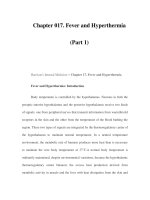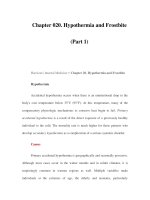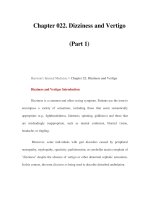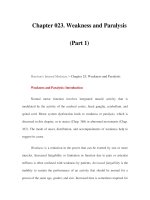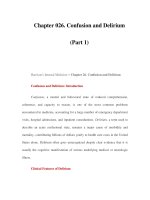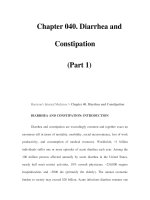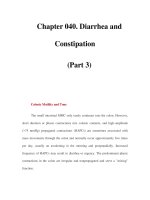Chapter 040. Diarrhea and Constipation (Part 1) docx
Bạn đang xem bản rút gọn của tài liệu. Xem và tải ngay bản đầy đủ của tài liệu tại đây (12.51 KB, 5 trang )
Chapter 040. Diarrhea and
Constipation
(Part 1)
Harrison's Internal Medicine > Chapter 40. Diarrhea and Constipation
DIARRHEA AND CONSTIPATION: INTRODUCTION
Diarrhea and constipation are exceedingly common and together exact an
enormous toll in terms of mortality, morbidity, social inconvenience, loss of work
productivity, and consumption of medical resources. Worldwide, >1 billion
individuals suffer one or more episodes of acute diarrhea each year. Among the
100 million persons affected annually by acute diarrhea in the United States,
nearly half must restrict activities, 10% consult physicians, ~250,000 require
hospitalization, and ~5000 die (primarily the elderly). The annual economic
burden to society may exceed $20 billion. Acute infectious diarrhea remains one
of the most common causes of mortality in developing countries, particularly
among children, accounting for 2–3 million deaths per year. Constipation, by
contrast, is rarely associated with mortality and is exceedingly common in
developed countries, leading to frequent self-medication and, in a third of those, to
medical consultation. Population statistics on chronic diarrhea and constipation are
more uncertain, perhaps due to variable definitions and reporting, but the
frequency of these conditions is also high. United States population surveys put
prevalence rates for chronic diarrhea at 2–7% and for chronic constipation at 12–
19%, with women being affected twice as often as men. Diarrhea and constipation
are among the most common patient complaints faced by internists and primary
care physicians, and they account for nearly 50% of referrals to
gastroenterologists.
Although diarrhea and constipation may present as mere nuisance
symptoms at one extreme, they can be severe or life-threatening at the other. Even
mild symptoms may signal a serious underlying gastrointestinal lesion, such as
colorectal cancer, or systemic disorder, such as thyroid disease. Given the
heterogeneous causes and potential severity of these common complaints, it is
imperative for clinicians to appreciate the pathophysiology, etiologic
classification, diagnostic strategies, and principles of management of diarrhea and
constipation, so that rational and cost-effective care can be delivered.
NORMAL PHYSIOLOGY
While the primary function of the small intestine is the digestion and
assimilation of nutrients from food, the small intestine and colon together perform
important functions that regulate the secretion and absorption of water and
electrolytes, the storage and subsequent transport of intraluminal contents
aborally, and the salvage of some nutrients after bacterial metabolism of
carbohydrate that are not absorbed in the small intestine. The main motor
functions are summarized in Table 40-1. Alterations in fluid and electrolyte
handling contribute significantly to diarrhea. Alterations in motor and sensory
functions of the colon result in highly prevalent syndromes such as irritable bowel
syndrome (IBS), chronic diarrhea, and chronic constipation.
Table 40-1 Normal Gastrointestinal Motility: Functions at Different
Anatomic Levels
Stomach and small bowel
Synchronized MMCs in fasting
Accommodation, trituration, mixing, transit
Stomach ~3 h
Small bowel ~3 h
Ileal reservoir empties boluses
Colon: irregular mixing, fermentation, absorption, transit
Ascending, transverse: reservoirs
Descending: conduit
Sigmoid/rectum: volitional reservoir
Note: MMC, migrating motor complex.
